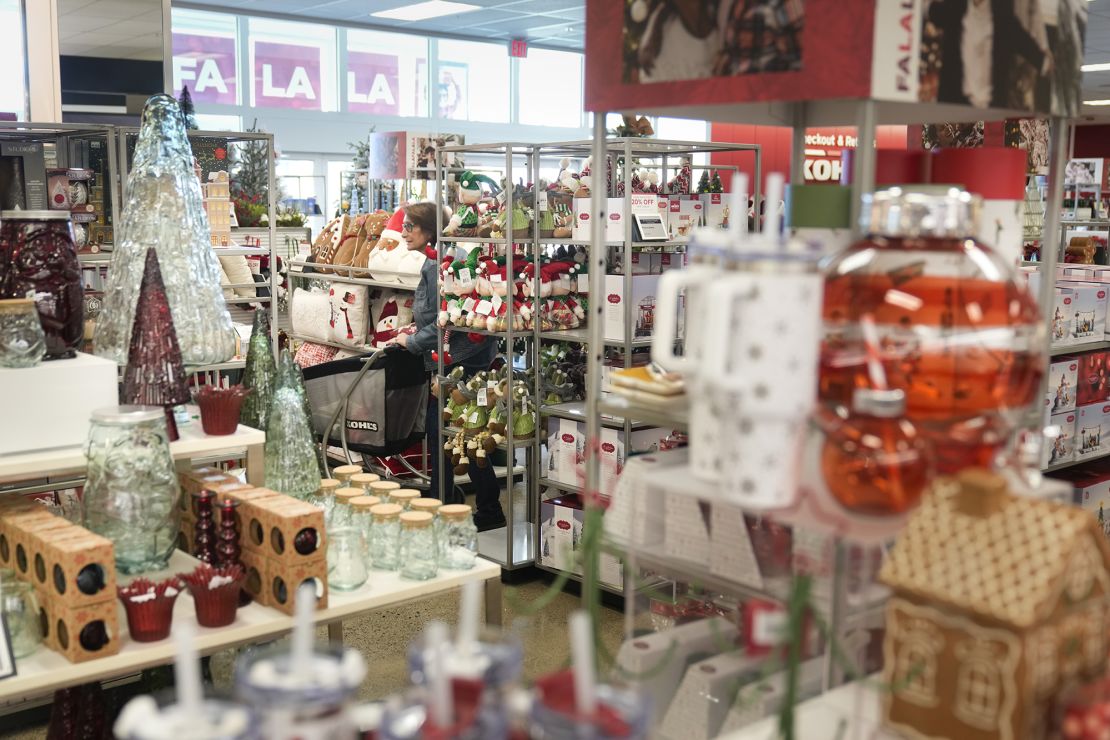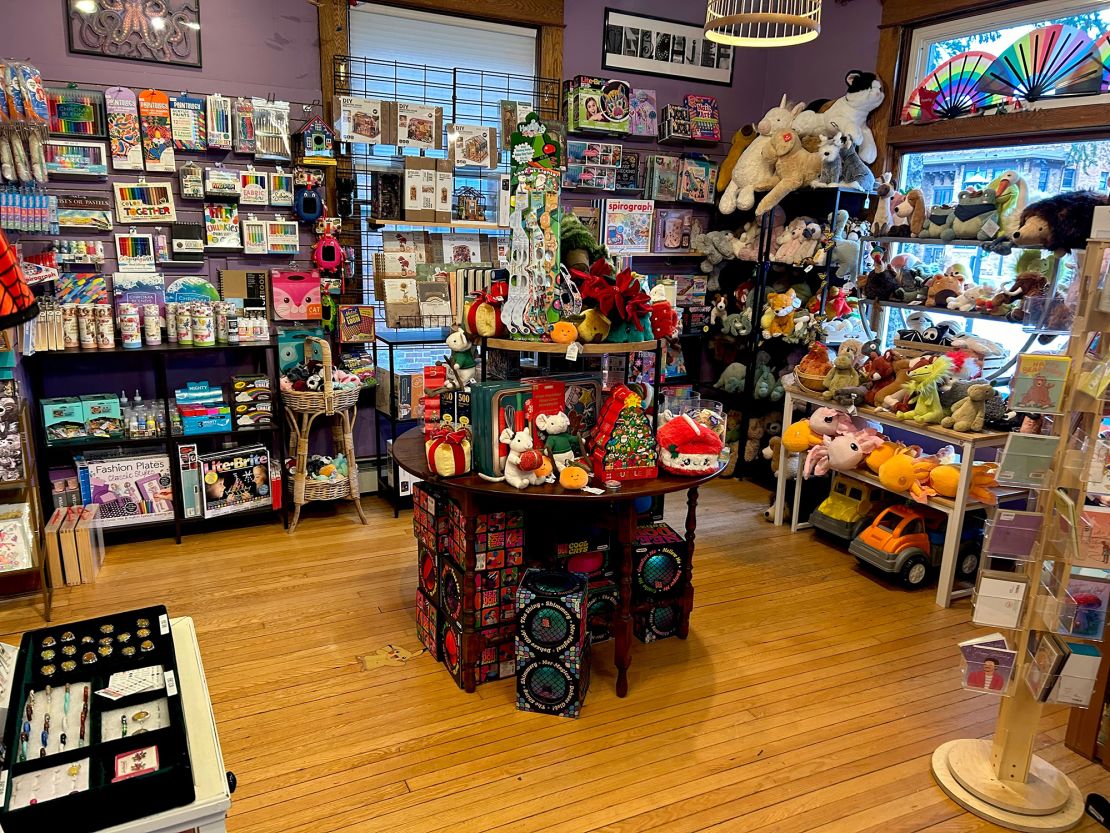Santa’s checking his list, elves in tow, as a model sailboat and selection of beach tees hang on the wall behind him. Strands of garlands drape across the ceiling as racks of women’s summer wear sit below.
It’s holiday time at B&B Department Stores, which has sold clothes, beachwear and accessories along the Jersey Shore for 50 years.
It’s also one of the biggest times of the year for B&B and other retailers.
While economists say this holiday shopping season could ultimately be the most normal one (sales-wise) since before the pandemic, it’s also decked out with plenty of uncertainty.
Americans, worn down by high prices, are carefully seeking out promotions. However, depending on the retailer, deals may be hard to come by. Rising debt and post-election sentiment are also holding some shoppers back, economists say, affecting the nation’s most crucial economic engine: consumer spending.
A ‘reasonable,’ not ‘blockbuster,’ holiday
Americans plan to spend $902 on average this year on gifts, food, decorations and other seasonal items, the National Retail Federation projected, citing its latest consumer survey.
That’s the largest expected per-person spend since 2019.
While it would set a new record as well (keep in mind, those figures aren’t adjusted for inflation), this holiday season might be a little more muted than last.
It might just be downright “reasonable” or “normal,” economists say.
“The consumer has got firepower and is able to out and spend, so it’s not going to be a miserable holiday by any standards,” said Neil Saunders, retail analyst and managing director at GlobalData Retail.
But, he added, “it’s not going to be a blockbuster holiday.”

“The consumer is very picky and is very discerning about what they buy and where they shop,” he said. “Because money is still quite tight, so they’re being very choosy about their buying behaviors.”
As such, some retailers will come out ahead and some will not, he said.
And some of that polarization is already on display, he said, noting strong sales at retailers such as Walmart (consumers drawn toward more essential items) and TJ Maxx (consumers wanting brand names but at a discount) and comparatively lackluster returns at Target (which leans more heavily toward discretionary items).
Target loaded up on inventory to get ahead of a US port strike (that ultimately was short-lived); however, customers reined in discretionary spending much more than the discount retailer expected, which resulted in a quarterly earnings miss that sent the company’s stock plummeting 20%.
Leaner inventories and retailers playing Scrooge
‘Tis the season for doorbuster deals, and while some retailers like Target indicated plans to go deeper into discounting, others could end up being a little stingier.
Last year, several major retailers ran heavy on inventory — a hangover from post-pandemic supply chain disruptions and consumer demand shifts. And when excess stock piles up in the back room and in the warehouses, the solution typically involves slashing prices to help move it out the door.
Retailers generally have been much more cautious this year, Saunders said, noting how consumer demand has been a bit choppier this time around as well.
“I think there’s a view that they would rather run out of inventory than be stuck with a lot of inventory that they then have to discount and really destroy their margins,” he said.
That could very well mean fewer deals — especially deep, last-minute discounts — for shoppers.
“We do expect to be less promotional than how we operated last year,” Franklin Bracken, chief commercial operator for Foot Locker, said during Goldman Sachs Global Retailing Conference in September, according to a FactSet transcript.

“Last year, we’re operating from a baseline of excess inventory that we knew we had to work through and more elevated inventory across the industry,” Bracken said, according to the transcript. “So, embedded in our guidance is that we’ll be less promotional year-over-year in the holiday.”
At B&B’s locations in New Jersey, the recipe for success from past years will still be cooked up this time around, Jeffrey Davidson, B&B’s executive vice president, told CNN.
“The Black Friday weekend runs almost 30% to 40% of my entire month’s sales, so they are big days,” he said. “And we do run promotions, and we offer free gift wrap, and we have other things that we do like offering up hot chocolate and cookies.”
“If you mark it down, they will come,” Davidson quipped.
A shortened holiday season
A short shopping season, however, may force the hands of retailers who are looking to hold back on deep promotions.
This year, there are 26 days between Thanksgiving and Christmas, marking the shortest holiday shopping season possible.
It’s also one of the reasons why the “Christmas creep” and the pull-forward of holiday deals feels more prevalent this year, said Shannon Grein, economist at Wells Fargo.
“It’s really turned into Black Friday week,” she said.
While it’s not an excessive amount of discounting, retailers are aware that consumers are price-fatigued and have some spending fatigue around discretionary items, she said.

“So, I think we’ll see some discounting, but it’ll be used as a strategic tool to get the consumer in the store, get the consumer online and hopefully facilitate just a larger basket of purchases.”
However, consumers this year aren’t as flush as in recent years.
Three-plus years of high inflation have compounded to sap away purchasing power and savings account balances. Credit card debt is on the rise and so are delinquencies, in a time of inflation-fighting high interest rates.
“I don’t think we’re yet in a worrying position from a debt perspective, from a purchasing perspective,” she said. “But we do continue to move in the direction of growing more vulnerable.”
While the extent of vulnerability cuts differently across households and socioeconomic brackets, overall holiday sales are expected to rise 3.3% this year, according to Wells Fargo projections.
If that bears out, that would be weaker than last year and the long-run average of 4.3%, according to Wells Fargo.
The National Retail Federation projected a similar sales gain, estimating winter holiday spending will grow by between 2.5% and 3.5% from last year to a range of $979.5 billion to $989 billion.
Sentiment on the upswing
Still, optimism has started to pick up on the consumer side.
A closely watched monthly gauge of consumer sentiment published by the University of Michigan last week moved upward to its highest reading since April.
A separate survey conducted by TransUnion found a bump in sentiment as well: Heading into the holidays, consumers were more optimistic about their household finances than this time last year, said Charlie Wise, TransUnion’s senior vice president of research and consulting.
Inflation remains top of mind for consumers and a major concern; however, wage gains have outpaced the rate of price hikes for the past year and a half, Wise said.

“Consumers may feel really bad about the inflation; but when push comes to shove, for many of them, they have the income, the spending power that can fuel a pretty decent holiday shopping season,” he said.
November’s University of Michigan consumer sentiment survey also showed some stark differences in economic outlooks: Following the election, consumer expectations amongst Republicans jumped 45% while Democrats’ expectations fell 19%, according to an Oxford Economics analysis of the University of Michigan’s consumer sentiment report.
“Despite the political polarization in the consumer sentiment reports, on balance the index is still trending higher. Lower gas prices, gains in equity markets, and falling interest rates have all given consumers something to be more optimistic about,” according to the research note released Friday.
Community-driven support
In the 25 years that Dan Marshall and his family have run a toy shop in St. Paul, Minnesota, there’s a fairly consistent inconsistency:
“Election years are always kind of weird years,” said Marshall, who runs Mischief Toy Store, which sells games, toys, gift, memorabilia and comics for all ages.
There’s typically hesitation in spending leading up to the election, but after November 6, it hit different for many customers of Mischief, which has a focus on diversity, social justice and other community-centric causes.
“I think people were really anxious coming into the election, and now the anxiety for our customer base has only increased,” he said. “So, we don’t know quite what to expect.”

Marshall remains quite optimistic that Mischief will enjoy yet another strong Black Friday, Small Business Saturday and, ultimately, holiday season.
“We’re expecting that people will be coming out for Black Friday, which is a big weekend for us, and that our sales will probably be pretty good,” he said, “because people will be looking to support community institutions that they believe in, especially during troubling times.”
Mischief also could see a continued bump from people — especially younger generations — who want to have that in-person experience, to see and browse merchandise, and get recommendations for someone they’re shopping for, he said.
“The default is just to order something up, and our mission is to create this environment where people will discover something new that they hadn’t even thought existed, where they’ll get some great ideas, where they’ll get personal service and free gift wrapping and stuff like that,” he said. “And it’s fun, because a lot of times, people had no idea that this is what a retail store used to be — and still is.”








